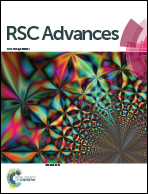Studies on the drastic improvement of photocatalytic degradation of acid orange-74 dye by TPPO capped CuO nanoparticles in tandem with suitable electron capturing agents†
Abstract
Highly stable copper oxide (CuO) nanoparticles are synthesized by a precipitation method and stabilized by in situ capping with triphenylphosphine oxide (TPPO). The as-synthesized CuO nanoparticles were characterized for average particle size (8 nm) by transmission electron micrography (TEM); an optical band gap of 2.29 eV by diffused reflectance spectroscopy and a large BET surface area (105.82 m2 g−1). The sunlight induced photocatalytic activity towards the degradation of acid orange 74 (an azo dye) by TPPO capped CuO nanoparticles was attributed to unfavorable electron capturing by molecular oxygen to produce reactive oxygen species. This is demonstrated from theoretical band structure calculations which revealed valence band edge (2.59 eV) and conduction band edge (0.29 eV) for TPPO capped CuO nanoparticles, which are unfavourable for electron transfer with respect to the redox potentials of O2/O2˙− (−0.2 eV) and H2O/˙OH (2.2 eV) in the NHE scale. Strikingly, TPPO capped CuO nanoparticles when mixed with 5 mM K2S2O8 exhibited 99% degradation of acid orange-74 in 180 min under sunlight exposure. A similar dye degradation efficiency was observed when CuO nanoparticles were mixed with H2O2 in the reaction medium. The mechanism for the drastic improvement in the dye degradation due to the addition of K2S2O8 or H2O2 has been explained on the basis of favorable redox couples of S2O82−/SO4˙− (2.01 eV) and H2O2/˙OH (0.87 eV) which could accept photoexcited electrons from the conduction band of CuO to produce reactive hydroxyl radical species. Using selective scavenger for reactive oxygen species, the generation of O2˙− was ruled out and hydroxyl radicals were confirmed as the major reactive oxygen species for the degradation of acid orange-74 dye. Ion chromatography studies of the aliquot left after sunlight induced photocatalytic dye degradation revealed anions, viz. nitrate, sulphate, oxalate and formate, which are released due to mineralization of the dye solution by a photocatalytic process. The performance of the photocatalytic dye degradation was unchanged for 5 repetitive catalytic cycles and hence it was concluded that TPPO capped CuO nanoparticles offer excellent photocatalytic dye degradation ability when suitable electron capturing agents like potassium persulphate are used in tandem.


 Please wait while we load your content...
Please wait while we load your content...